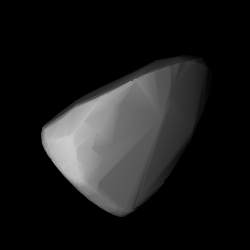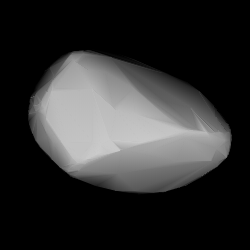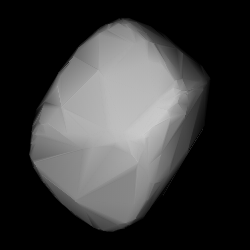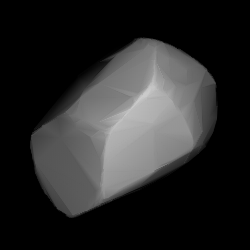Related Research Articles

1050 Meta, provisional designation 1925 RC, is a stony Eunomia asteroid from the central regions of the asteroid belt, approximately 10 kilometers in diameter. It was discovered on 14 September 1925, by German astronomer Karl Reinmuth at the Heidelberg Observatory in southwest Germany. The meaning of the asteroids's name is unknown. The presumably S-type asteroid has a rotation period of 6.14 hours and possibly an elongated shape.

1554 Yugoslavia, provisional designation 1940 RE, is a stony Eunomian asteroid from the middle region of the asteroid belt, approximately 16 kilometres (9.9 mi) in diameter. It was discovered by Serbian astronomer Milorad Protić at Belgrade Astronomical Observatory, Serbia, on 6 September 1940. It was named for the former country of Yugoslavia.
1106 Cydonia, provisional designation 1929 CW, is a Eunomian asteroid from the central regions of the asteroid belt, approximately 13 kilometers in diameter. It was discovered on 5 February 1929, by astronomer Karl Reinmuth at the Heidelberg-Königstuhl State Observatory in Germany. The asteroid was named for the fruit-bearing tree Cydonia (quince). The S-type asteroid has a relatively short rotation period of 2.7 hours.
4149 Harrison, provisional designation 1984 EZ, is a stony Eunomian asteroid from the middle region of the asteroid belt, approximately 10 kilometers in diameter. The asteroid was discovered on 9 March 1984, by American astronomer Brian Skiff at Lowell's Anderson Mesa Station in Flagstaff, Arizona, and named after musician George Harrison.

1160 Illyria, provisional designation 1929 RL, is a stony Maria asteroid from the central regions of the asteroid belt, approximately 13 kilometers in diameter. It was discovered on 9 September 1929, by German astronomer Karl Reinmuth at the Heidelberg Observatory in southwest Germany. The asteroid was named after the ancient region of Illyria, located on the Balkan Peninsula.
12848 Agostino, provisional designation 1997 NK10, is a stony Eunomia asteroid from the central region of the asteroid belt, approximately 5 kilometers in diameter.
21558 Alisonliu, provisional designation 1998 QW77, is a stony Eunomia asteroid from the middle region of the asteroid belt, approximately 8 kilometers in diameter. It was discovered on 24 August 1998, by the Lincoln Near-Earth Asteroid Research at the Lincoln Laboratory's Experimental Test Site in Socorro, New Mexico, United States. The asteroid was named for Alison Liu, a 2006 ISEF awardee.

1510 Charlois, provisional designation 1939 DC, is a carbonaceous Eunomia asteroid from the middle region of the asteroid belt, approximately 24 kilometers in diameter.

1275 Cimbria is a Eunomia asteroid from the central regions of the asteroid belt, approximately 27 kilometers in diameter. It was discovered on 30 November 1932, by astronomer Karl Reinmuth at the Heidelberg-Königstuhl State Observatory in southern Germany. The asteroid was named after the Cimbri, an ancient Germanic tribe.

2181 Fogelin is an Eunomia asteroid from the central regions of the asteroid belt, approximately 11 kilometers in diameter. It was discovered on 28 December 1942, by Germany astronomer Karl Reinmuth at the Heidelberg Observatory in southwest Germany. In 1980, it was named for Eric S. Fogelin an assistant at the Minor Planet Center. The likely elongated S-type asteroid has a rotation period of 14.07 hours.
2005 Hencke, provisional designation 1973 RA, is a stony Eunomia asteroid from the middle region of the asteroid belt, approximately 10 kilometers in diameter. It was discovered by Swiss astronomer Paul Wild at Zimmerwald Observatory near Bern, Switzerland, on 2 September 1973. The asteroid was named after German amateur astronomer Karl Ludwig Hencke.
1384 Kniertje, provisional designation 1934 RX, is a dark Adeonian asteroid from the central regions of the asteroid belt, approximately 26 kilometers in diameter. It was discovered on 9 September 1934, by Dutch astronomer Hendrik van Gent at the Union Observatory in Johannesburg, South Africa. The asteroid was named after a character in the Dutch play Op Hoop van Zegen by Herman Heijermans.
1238 Predappia, provisional designation 1932 CA, is a dark Adeonian asteroid from the central regions of the asteroid belt, approximately 21 kilometers in diameter. It was discovered on 4 February 1932, by astronomer Luigi Volta at the Observatory of Turin in Pino Torinese, Italy. It was later named after the Italian village of Predappio.
2308 Schilt, provisional designation 1967 JM, is a stony Eunomia asteroid from the asteroid belt, approximately 17 kilometers in diameter. It was discovered on 6 May 1967, by Argentine astronomer Carlos Cesco together with American astronomer Arnold Klemola at the Yale–Columbia Southern Station at Leoncito Astronomical Complex in Argentina.

2384 Schulhof (prov. designation: 1943 EC1) is a mid-sized asteroid and the namesake of the Schulhof family, located in the Eunomian region of the intermediate asteroid belt. It was discovered on 2 March 1943, by French astronomer Marguerite Laugier at Nice Observatory in southeastern France. The asteroid was later named after Hungarian astronomer Lipót Schulhof. The presumed S-type asteroid has a short rotation period of 3.3 hours and measures approximately 12 kilometers (7.5 miles) in diameter.

6882 Sormano (prov. designation: 1995 CC1) is an stony Eunomia asteroid from the middle region of the asteroid belt, approximately 7 kilometers (4.3 miles) in diameter. It was discovered on 5 February 1995, by Italian amateur astronomers Piero Sicoli and Valter Giuliani at Sormano Astronomical Observatory in northern Italy. The asteroid was named for the Italian mountain-village of Sormano and its discovering observatory.
4085 Weir, provisional designation 1985 JR, is a stony Eunomian asteroid from the central regions of the asteroid belt, approximately 10 kilometers in diameter. It was discovered on 13 May 1985, by astronomer Carolyn Shoemaker at the Palomar Observatory in California, United States. The asteroid was named after American geologist Doris Blackman Weir.
5855 Yukitsuna, provisional designation 1992 UO2, is a stony Marian asteroid from the central regions of the asteroid belt, approximately 11 kilometers (7 miles) in diameter. It was discovered on 26 October 1992, by Japanese astronomers Akira Natori and Takeshi Urata at the JCPM Yakiimo Station. The likely elongated S-type asteroid has a rotation period of 19 hours. It was named for Minamoto no Yukitsuna, a Japanese general during the Heian era.
13390 Bouška, provisional designation 1999 FQ3, is a stony Eunomia asteroid from the central region of the asteroid belt, approximately 7 kilometers in diameter. It was discovered by Czech astronomers Petr Pravec and Marek Wolf at Ondřejov Observatory in the Czech Republic on 18 March 1999. It was named after astronomer Jiří Bouška.
24260 Kriváň, provisional designation 1999 XW127, is a stony Eunomian asteroid from the middle region of the asteroid belt, approximately 8 kilometers in diameter. It was discovered by Slovak astronomer Peter Kušnirák at the Czech Ondřejov Observatory on 13 December 1999, and named after the Kriváň mountain peak in Slovakia.
References
- 1 2 3 4 "JPL Small-Body Database Browser: 5256 Farquhar (1988 NN)" (2016-08-03 last obs.). Jet Propulsion Laboratory . Retrieved 21 June 2017.
- 1 2 3 4 Schmadel, Lutz D. (2007). "(5256) Farquhar". Dictionary of Minor Planet Names – (5256) Farquhar. Springer Berlin Heidelberg. p. 451. doi:10.1007/978-3-540-29925-7_5084. ISBN 978-3-540-00238-3.
- 1 2 3 4 5 6 "LCDB Data for (5256) Farquhar". Asteroid Lightcurve Database (LCDB). Retrieved 9 September 2016.
- 1 2 3 Masiero, Joseph R.; Grav, T.; Mainzer, A. K.; Nugent, C. R.; Bauer, J. M.; Stevenson, R.; et al. (August 2014). "Main-belt Asteroids with WISE/NEOWISE: Near-infrared Albedos". The Astrophysical Journal. 791 (2): 11. arXiv: 1406.6645 . Bibcode:2014ApJ...791..121M. doi:10.1088/0004-637X/791/2/121 . Retrieved 9 September 2016.
- 1 2 3 4 Mainzer, A.; Grav, T.; Masiero, J.; Hand, E.; Bauer, J.; Tholen, D.; et al. (November 2011). "NEOWISE Studies of Spectrophotometrically Classified Asteroids: Preliminary Results". The Astrophysical Journal. 741 (2): 25. arXiv: 1109.6407 . Bibcode:2011ApJ...741...90M. doi:10.1088/0004-637X/741/2/90.
- 1 2 Odden, Caroline E.; Bond, J. Brooke; Aggarwal, Ashok K.; Seokjun, Yoon; Chapman, Kathryn J.; Fortin, Liam G.; et al. (October 2014). "Lightcurve Analysis for Three Asteroids: 4000 Hipparchus, 5256 Farquhar and 5931 Zhvanetskij". The Minor Planet Bulletin. 41 (4): 274–275. Bibcode:2014MPBu...41..274O. ISSN 1052-8091 . Retrieved 9 September 2016.
- ↑ Veres, Peter; Jedicke, Robert; Fitzsimmons, Alan; Denneau, Larry; Granvik, Mikael; Bolin, Bryce; et al. (November 2015). "Absolute magnitudes and slope parameters for 250,000 asteroids observed by Pan-STARRS PS1 - Preliminary results". Icarus. 261: 34–47. arXiv: 1506.00762 . Bibcode:2015Icar..261...34V. doi:10.1016/j.icarus.2015.08.007 . Retrieved 9 September 2016.
- 1 2 "5256 Farquhar (1988 NN)". Minor Planet Center. Retrieved 9 September 2016.
- ↑ "MPC/MPO/MPS Archive". Minor Planet Center. Retrieved 9 September 2016.